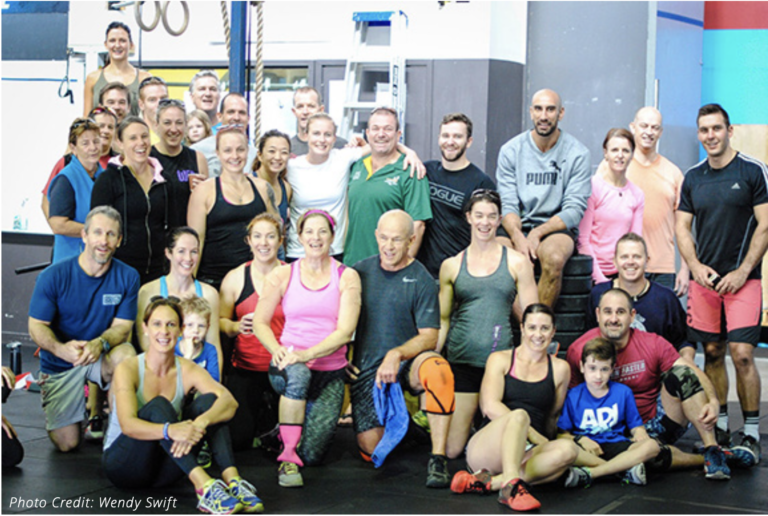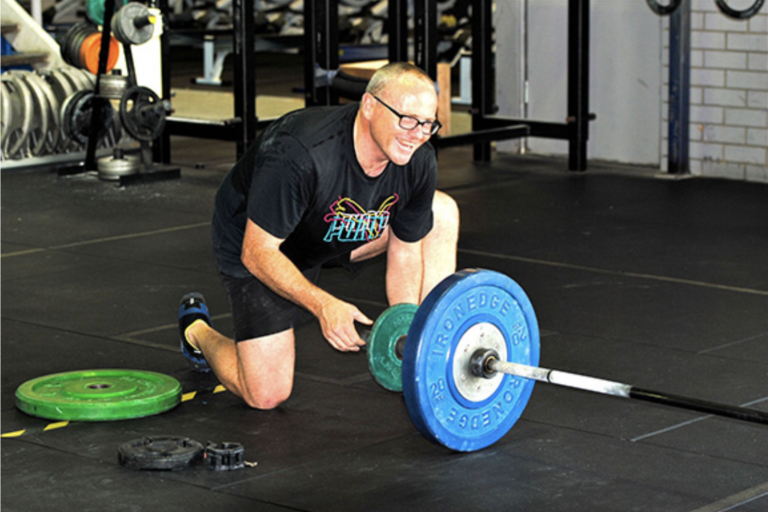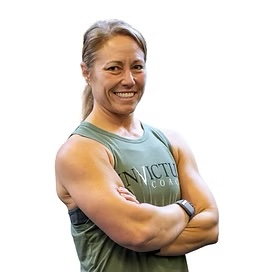Coaching aging CrossFit athletes requires a thoughtful approach that considers their unique needs and challenges. This guide provides essential guidelines for delivering successful and worthwhile classes for these athletes.
But first, a definition:
Masters/aging/older athletes: athletes who are approximately 55 and over, not to be confused with athletes who compete at the Masters division at CrossFit competitions.
I’ve mapped out this article based on the typical flow of a daily workout, so you can remember a few items to focus on during each class section the next time you hit the floor.

Warm-up – Longer and More Gradual
As athletes age, recovery time increases, and mobility work becomes essential. Incorporate sufficient warm-ups that elevate heart rate and body temperature gradually.
Monostructural Warm-Up
- Provide additional time to get the body moving.
- Encourage athletes to arrive earlier to warm up at their own pace.
- Gradually elevate heart rate to prepare the cardiovascular system.
- Address decreased circulation and capillary viscosity from aging that limits nutrient and oxygen delivery to muscles.
- Use this time to let athletes talk about how they’re feeling that day, what they’re looking forward to loosening up, and what made them show up. What you talk about will differ based on your athletes; only you know what resonates with them. No matter what, this is a good time to check in and let them check in with each other.
Mobility Component
- Mobility exercises in classes for aging athletes are non-negotiable.
- Mature athletes often mention “achy joints” and “stiffness,” particularly in early morning classes.
- Joints stiffen, muscles tighten, and movement patterns degrade as joints become less lubricated and cartilage wears down over time.
- Include exercises like hip openers, shoulder rotations, and ankle stretches.
- Functional mobility (performing everyday movements and activities necessary for independent living) helps lubricate joints and tendons, and is important to focus on inside the gym so it can be applied outside the gym.
- Being able to bend, twist, reach, and walk easily is key to aging well and maintaining independence.
Specific Warm-up – Build Functional Movement
Form and Technique Focus
- Emphasize proper form and technique, especially with complex lifts and high-impact movements.
- Know your athletes and maintain safety at all times.
- If a movement doesn’t cause damage and the athlete can perform it, let them perform it.
- Work toward proper mechanics first, then consistency, before adding intensity.
- Create virtuosity with those movements and translate them into everyday life.
Building Functional Range of Motion
- For athletes newer to CrossFit, focus on correcting movement and mechanics.
- This process may require patience, as proper movement often requires breaking bad habits.
- Take time to understand your athletes’ medical history and modify exercises as needed.
- Be mindful of shoulder, knee, and lower back health, as these areas can be particularly vulnerable.
- Some athletes may have had surgeries requiring hardware and may be limited in their range of motion.
- Consider cardiac limitations, such as medications or pacemakers, that prevent heart rates from rising.
Give Extra Time for Gradual Build-Up
- Aging athletes often need more time to transition between movements.
- Allow for progressive loading and movement complexity.
- Gradually build intensity through the specific warm-up.
- Focus on movements that will appear in the upcoming workout.

Workout – Adapt Intensity and Volume if Needed
While CrossFit training is often programmed as high intensity, older athletes may not be able to manage the same intensity or volume as their younger counterparts. That’s a big maybe, though. There are plenty of athletes over 55 in affiliates all over the world who can give 20 and 30-somethings a run for their money. So, as always, the better you know your athletes, the better you can help them if they need to adapt.
Workout Format Adaptations
- Prioritize workout quality and adjust training volume just as you would for any athlete.
- Become a master at coming up with different ways to reduce volume, distance, and/or range of motion while maintaining the intended stimulus.
- If an Rx’d workout calls for “rounds for time,” you might consider turning it into an AMRAP with a similar stimulus and time cap.
- Some older athletes find it challenging to transition quickly, so adapt things like EMOMs by using different rep schemes or time domains.
- Reduce WOD format/scheme complexity while maintaining the intended stimulus.
Creative Substitutions
- Consider lower-intensity time-controlled tasks when valuable — for example, a brisk 2-minute walk for a 400-meter run.
- Decrease weights to amounts they might encounter in daily life, such as a bag of potatoes, kitty litter, or even a young grandchild, if that is as heavy as they can go.
- If balance is an issue, use a wall or the rig (similar to a railing) or a PVC pipe (similar to a cane) to provide added stability and confidence.
Maintain Challenge
- While adapting, continue to challenge these athletes appropriately. Many can still lift significantly heavy weights, and that’s a great thing to encourage.
- Encourage, work toward, and hold standards just as you would for any athlete.
- Acknowledge aging athletes’ limitations, but don’t underestimate their capabilities.
- Some older athletes may require more individualized programming within the group setting. This isn’t easy to do in a full group class. Still, with some thought and preparation, it is possible to identify a range of scales or movements that will work best for athletes in a masters class, just as is required of you in a regular group class where people have injuries or other limitations they are working with.
Cool Down – What and Why
- Allow time for cool-downs, such as a group walk, to bring athletes’ heart rates back down.
- Add mobility work during the cool-down phase.
- Take time to assess proper recovery to homeostasis.
- A proper cool-down helps address the delayed clearance of waste products like lactic acid.
Recovery – Essential Considerations
Recovery becomes increasingly important for older athletes due to several physiological factors:
- Muscle recovery after intense exercise takes longer for more mature athletes.
- Tissue repair slows with age due to declining collagen and muscle fiber production.
- Sarcopenia (age-related muscle loss) leads to weaker muscles that fatigue quicker and recover more slowly, though with regular CrossFit training, these things can improve significantly.
- The clearance of waste products like lactic acid is delayed, leading to slower recovery.
- Testosterone, growth hormone, and IGF-1 (crucial for recovery and muscle growth) decline with age, contributing to slower muscle repair and lower energy levels.
- What takes a day of recovery for a younger athlete may take twice as long for an older athlete due to slowed circulation and waste removal.
Recovery Strategies
- Encourage athletes to refuel and rehydrate immediately after training to aid the recovery process.
- Suggest appropriate rest days between high-intensity sessions.
- Educate on the importance of sleep quality for recovery.
- Consider recommending appropriate recovery modalities like light movement, stretching, or compression.
- Remind them that recovery rates can and will improve the longer they train.
Understanding Motivation
Older athletes often have different motivations compared to younger athletes:
- Some may be motivated by competition, while others prioritize longevity, strength, health, or socialization.
- Keep communication open about personal goals.
- Foster positive reinforcement around progress.
- By understanding and respecting each athlete’s unique motivation, you can build a supportive community.
- Show appreciation for each athlete’s hard work.
Social Aspect
- The social aspect of CrossFit is a huge motivator, especially for older athletes.
- Team workouts and challenges can boost community and engagement.
- Keep it inclusive, fun, and supportive.
- Create an environment where athletes feel valued and integral to each other’s success.
The Masters Athlete Mindset
Unlike younger athletes, who may focus more on peak performance or competition, mature athletes tend to have a broader view of exercise.
- Older athletes prioritize maintaining health over breaking records.
- They have a heightened awareness of how their bodies respond and recover.
- They focus on working smarter instead of harder.
- Mental clarity, emotional balance, and quality of life are sought through exercise rather than focusing solely on appearance or achievements.
- Experienced athletes usually have stronger mental fortitude.
- They’re more likely to modify training by replacing high-impact routines with lower-impact options, changing volume, or focusing on recovery days rather than disregarding pain or warning signs.
- Resilience develops through years of setbacks, plateaus, and comebacks.
- They understand progress isn’t always linear, and patience is key.
- Seasoned athletes often find gratitude in daily training and appreciate the ability to maintain physical fitness.
- They also value community, camaraderie, and supporting others in their fitness journeys.
As a coach, don’t treat your mature athletes as if they don’t understand or can’t relate. Be open to learning from them; they likely have more experience than you realize.
Have a question for a coach? Please submit that here.
 Heidi Moody is a 52-year-old Certified CrossFit Level 3 Trainer who coaches at
Heidi Moody is a 52-year-old Certified CrossFit Level 3 Trainer who coaches at